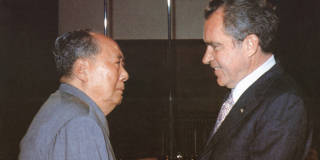The historic 1972 meeting between the US and Chinese leaders arguably indicated that there could be no permanent peace in the world unless the two countries were able to work together. At the same time, open societies must never forget that democratic values remain a better long-term bet than totalitarianism.
LONDON – In Seize the Hour, her excellent book about the first meeting between US President Richard Nixon and Communist Party of China Chairman Mao Zedong in Beijing, the historian Margaret MacMillan enumerated some of the profound implications of this extraordinary encounter. The meeting, which took place 50 years ago this month, ended a long political standoff between the United States and communist China, and marked the beginning of a new geopolitical era. And it indicated, perhaps, that there could be no permanent peace in the world unless China and America were able to work together.
But what should be the basis for the Sino-American relationship? For Nixon and his national security adviser, Henry Kissinger, the meeting was to undermine the Soviet Union’s global influence by driving a wedge between the world’s two most important communist countries. Nixon’s visit also enhanced his reputation as a global statesman, whatever his domestic reputation in the US. As Chinese Premier Zhou Enlai observed, “a farsighted man” who knew how to steer the helm of the ship of state through stormy waters had fundamentally changed the way that China and America dealt with each other.
There were also short-term consequences, of course. Nixon’s visit may have encouraged North Vietnam to be more responsive to America’s efforts to end the Vietnam War. The Soviet Union certainly was very concerned about the historic US-China rapprochement, and some of America’s Asian allies – Japan and Taiwan, for example – worried that the US might push them to one side.

LONDON – In Seize the Hour, her excellent book about the first meeting between US President Richard Nixon and Communist Party of China Chairman Mao Zedong in Beijing, the historian Margaret MacMillan enumerated some of the profound implications of this extraordinary encounter. The meeting, which took place 50 years ago this month, ended a long political standoff between the United States and communist China, and marked the beginning of a new geopolitical era. And it indicated, perhaps, that there could be no permanent peace in the world unless China and America were able to work together.
But what should be the basis for the Sino-American relationship? For Nixon and his national security adviser, Henry Kissinger, the meeting was to undermine the Soviet Union’s global influence by driving a wedge between the world’s two most important communist countries. Nixon’s visit also enhanced his reputation as a global statesman, whatever his domestic reputation in the US. As Chinese Premier Zhou Enlai observed, “a farsighted man” who knew how to steer the helm of the ship of state through stormy waters had fundamentally changed the way that China and America dealt with each other.
There were also short-term consequences, of course. Nixon’s visit may have encouraged North Vietnam to be more responsive to America’s efforts to end the Vietnam War. The Soviet Union certainly was very concerned about the historic US-China rapprochement, and some of America’s Asian allies – Japan and Taiwan, for example – worried that the US might push them to one side.